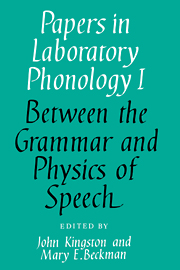Book contents
- Frontmatter
- Contents
- List of contributors
- Acknowledgements
- 1 Introduction
- 2 Where phonology and phonetics intersect: the case of Hausa intonation
- 3 Metrical representation of pitch register
- 4 The status of register in intonation theory: comments on the papers by Ladd and by Inkelas and Leben
- 5 The timing of prenuclear high accents in English
- 6 Alignment and composition of tonal accents: comments on Silverman and Pierrehumberf's paper
- 7 Macro and micro F0 in the synthesis of intonation
- 8 The separation of prosodies: comments on Kohler's paper
- 9 Lengthenings and shortenings and the nature of prosodic constituency
- 10 On the nature of prosodic constituency: comments on Beckman and Edwards's paper
- 11 Lengthenings and the nature of prosodic constituency: comments on Beckman and Edwards's paper
- 12 From performance to phonology: comments on Beckman and Edwards's paper
- 13 The Delta programming language: an integrated approach to nonlinear phonology, phonetics, and speech synthesis
- 14 The phonetics and phonology of aspects of assimilation
- 15 On the value of reductionism and formal explicitness in phonological models: comments on Ohala's paper
- 16 A response to Pierrehumbert's commentary
- 17 The role of the sonority cycle in core syllabification
- 18 Demisyllables as sets of features: comments on Clements's paper
- 19 Tiers in articulatory phonology, with some implications for casual speech
- 20 Toward a model of articulatory control: comments on Browman and Goldstein's paper
- 21 Gestures and autosegments: comments on Browman and Goldstein's paper
- 22 On dividing phonetics and phonology: comments on the papers by Clements and by Browman and Goldstein
- 23 Articulatory binding
- 24 The generality of articulatory binding: comments on Kingston's paper
- 25 On articulatory binding: comments on Kingston's paper
- 26 The window model of coarticulation: articulatory evidence
- 27 Some factors influencing the precision required for articulatory targets: comments on Keating's paper
- 28 Some regularities in speech are not consequences of formal rules: comments on Keating's paper
- Index of names
- Index of subjects
1 - Introduction
Published online by Cambridge University Press: 08 February 2010
- Frontmatter
- Contents
- List of contributors
- Acknowledgements
- 1 Introduction
- 2 Where phonology and phonetics intersect: the case of Hausa intonation
- 3 Metrical representation of pitch register
- 4 The status of register in intonation theory: comments on the papers by Ladd and by Inkelas and Leben
- 5 The timing of prenuclear high accents in English
- 6 Alignment and composition of tonal accents: comments on Silverman and Pierrehumberf's paper
- 7 Macro and micro F0 in the synthesis of intonation
- 8 The separation of prosodies: comments on Kohler's paper
- 9 Lengthenings and shortenings and the nature of prosodic constituency
- 10 On the nature of prosodic constituency: comments on Beckman and Edwards's paper
- 11 Lengthenings and the nature of prosodic constituency: comments on Beckman and Edwards's paper
- 12 From performance to phonology: comments on Beckman and Edwards's paper
- 13 The Delta programming language: an integrated approach to nonlinear phonology, phonetics, and speech synthesis
- 14 The phonetics and phonology of aspects of assimilation
- 15 On the value of reductionism and formal explicitness in phonological models: comments on Ohala's paper
- 16 A response to Pierrehumbert's commentary
- 17 The role of the sonority cycle in core syllabification
- 18 Demisyllables as sets of features: comments on Clements's paper
- 19 Tiers in articulatory phonology, with some implications for casual speech
- 20 Toward a model of articulatory control: comments on Browman and Goldstein's paper
- 21 Gestures and autosegments: comments on Browman and Goldstein's paper
- 22 On dividing phonetics and phonology: comments on the papers by Clements and by Browman and Goldstein
- 23 Articulatory binding
- 24 The generality of articulatory binding: comments on Kingston's paper
- 25 On articulatory binding: comments on Kingston's paper
- 26 The window model of coarticulation: articulatory evidence
- 27 Some factors influencing the precision required for articulatory targets: comments on Keating's paper
- 28 Some regularities in speech are not consequences of formal rules: comments on Keating's paper
- Index of names
- Index of subjects
Summary
While each of the papers in this volume has its specific individual topic, collectively they address a more general issue, that of the relationship between the phonological component and the phonetic component. This issue encompasses at least three large questions. First, how, in the twin processes of producing and perceiving speech, do the discrete symbolic or cognitive units of the phonological representation of an utterance map into the continuous psychoacoustic and motoric functions of its phonetic representation? Second, how should the task of explaining speech patterns be divided between the models of grammatical function that are encoded in phonological representations and the models of physical or sensory function that are encoded in phonetic representations? And third, what sorts of research methods are most likely to provide good models for the two components and for the mapping between them?
Previous answers to these questions have been largely unsatisfactory, we think, because they have been assumed a priori, on the basis of prejudices arising in the social history of modern linguistics. In this history, phonology and phonetics were not at first distinguished. For example, in the entries for the two terms in the Oxford English Dictionary each is listed as a synonym for the other; phonology is defined as “The science of vocal sounds (= PHONETICS)” and phonetics as “The department of linguistic science which treats of the sounds of speech; phonology.”
- Type
- Chapter
- Information
- Papers in Laboratory Phonology , pp. 1 - 16Publisher: Cambridge University PressPrint publication year: 1990
- 8
- Cited by

